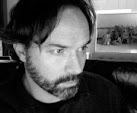
I'm hoping to get to NYC this month to take in a few shows, foremost The Edge of Vision at the Aperture Gallery. I cheated myself and bought the beautiful monograph first, something I don't usually do before seeing a show.
Abstraction, or a broader classification that I call 'experimental' photography, was what first drew me in after years of dispassionately knowing the techne of the medium. I learned photography at an early age from my father, a Marine Corps photojournalist and instructor. But I was never attracted the idea of being a photographer - no yearbook or newspaper staff in school, no photographic curiosity to speak of.
What first piqued my interest were crossover artists: Laslo Moholy-Nagy, Robert Rauschenberg, Robert Smithson, Sol LeWitt, and LeCorbusier the architect painting (often in the nude) to exercise his vision and sense of composition. Bolstered by friends immersed in art and literature, I began experimenting with painting, collage and photography to inform the aesthetics of my architectural work. Along the way I discovered great image-makers who forever changed the way that I see: Harry Callahan, Ray Metzker, Barbara Morgan, and Sigmar Polke among others. I searched for ways (relatively unsuccessful to this day) to generate architectural form and aesthetics through art mediums.
My early experimental photographic work was largely predicated on dissolving the illusion of deep space and expanding the 'frozen moment' into something not so... singular. Reading these abstractions, I made many attempts to translate the resulting forms back into architectural compositions. The only results which I thought began to translate successfully were in my brief series Brutalities / Cartographies. These images began as recording architecture and in a sense were regurgitated into a more interesting image of an architecture. I made a few line drawings and projections inspired by my friend Mark Kroeckel (of OpenShop Studio) and his exploration Acting Space, but alas, I let the project rest. All of these photo>architecture translations seemed forced, arbitrary, and ultimately aesthetic.
Which brings me (via the scenic route) to a thought about Joerg Colberg's Not a Review of the Edge of Vision show. As a photographic outsider (in a sense, never formally schooled in photography) I find it very interesting observing the differences between the few aesthetic ideologies in contemporary photography today. Joerg states, "I have never spent much time looking at abstract photography, because, well, I find most of it too decorative." I admire Joerg's eye and his blog commentary. A fair opinion, I suppose.
What I find interesting is that in the field of architecture, formal and visual abstraction is actually the basis of modern and conceptual design - quite different than in photography. The antithesis of this kind of architecture might be postmodern architecture... which is very different than postmodernism and all of it's derivatives in the world of art and photography.
Based on my history, my inclination here is to make a connection between abstract photography as seen in The Edge of Vision and modern design. Maybe that connection is simplistic. Maybe the connection is in the relation of the two mediums (photography and architecture) to people - how each affects our thoughts and interactions.
From reading his blog for a couple of years, I deduce that Joerg seems largely intrigued with portraiture - the relationships among: the photographer, a person as subject, the camera and ultimately the art object result on the wall. Among these relations are intense subtleties which reveal interesting aspects of the human condition. Eyes looking there, the gesture of the hand, light revealing lines on skin... all captured in the medium and speaking to us about what it is to be human.
There is much more here to think about here... I'll rest my fingers for a while. Maybe I'll expand my thoughts on abstraction and humanism in photography at a later date.

No comments:
Post a Comment